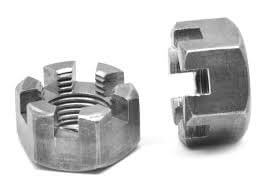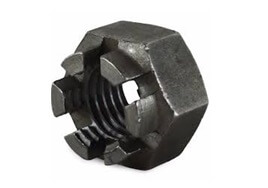What is the Difference Between a Castle Nut and a Slotted Nut?
Often called axle nuts as this is where they are most commonly found, castle and slotted nuts are hexagon nuts with turrets and slots on the top which resemble a castle wall. These types of nuts are used in conjunction with bolts that have holes in the end through which a locking pin can pass to lock the nut into position and prevent any further rotation. The locking pin is usually a split cotter pin, an R clip, a spring pin or a safety wire.
The main difference between castle and slotted nuts is found on the turret end section where the split pin is found. On the castle nut the end section is turned down slightly, enabling the split pin to be wound round and pinned against the turret so that the pin does not protrude. On a slotted nut this is not possible. Other than that they both have the same functionality.
On a slotted nut the diameter of the castellated section is the same as the main wrenching section of the nut (unlike a castle nut where the diameter of the castellated section is slightly smaller than the main wrenching part).
| SLOTTED NUT | CASTLE NUT |
 |
 |

